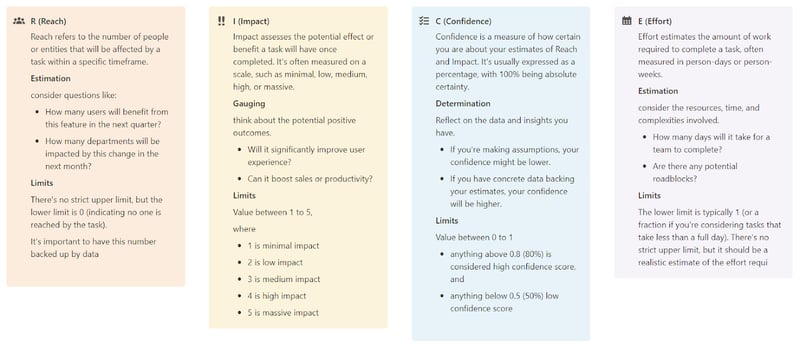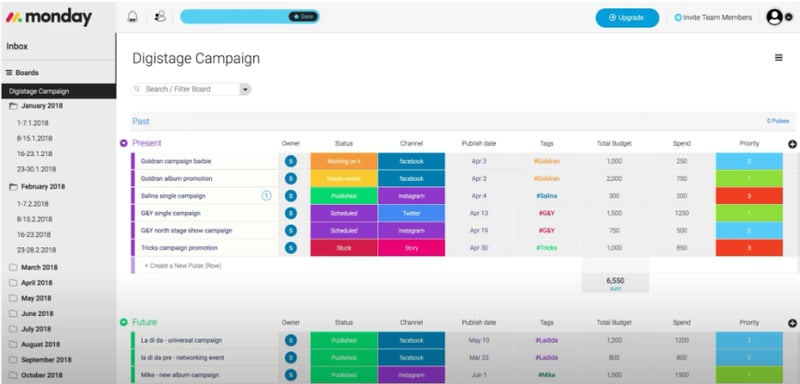How to Measure Reach and Impact in RICE?

Brandon Foster
Posted on January 17, 2024

Prioritizing what to build next is one of the toughest parts of being a product manager. There are always a million different options and opinions on what's most important. How do you make the right call?
You could just go with your gut. But as your team and product grows, that won’t cut it anymore. You need a way to get objective about prioritization to align your roadmap with what would really move the needle for your business.
The RICE prioritization framework is a simple and effective tool for prioritizing features, projects, and initiatives in product management. It stands for:
- Reach: The number of people who will be affected by the change.
- Impact: The size and importance of the effect the change will have.
- Confidence: How sure you are about the estimates for reach and impact.
- Effort: The amount of time and resources required to implement the change.
By considering these four factors, you can calculate a RICE score for each item on your roadmap. The higher the RICE score, the higher the priority.
RICE score = (Reach x Impact x Confidence) / Effort

The RICE framework is an excellent way to:
- Make data-driven decisions: By quantifying the potential value of each item, you can take the guesswork out of prioritization.
- Align stakeholders: The RICE score provides a clear and concise way to communicate the rationale behind your decisions.
- Track progress: You can use RICE scores to measure the actual impact of your initiatives and refine your estimates over time.
How Do You Measure Reach and Impact in RICE?
Measuring reach and impact is critical for any marketing or communications campaign. With monday dev (the work management platform my team uses), it's easy to track key metrics to understand how your initiatives are performing.
Below are some tips for measuring reach and impact in RICE using examples from the work management tools my team uses.
1. How Can You Track Reach?
With monday dev, you can easily track reach by looking at metrics like:
- Email subscribers - Track subscriber growth over time with a simple number item. Set a goal for list growth and monitor progress.
- Social media followers - Connect your social accounts to monitor follower counts across platforms like Facebook, Twitter, and LinkedIn. Track increases and set benchmarks.
- Website visitors - Integrate Google Analytics to monitor unique visitors and traffic to your site. Monitor trends and set goals for growth.
2. How Can You Track Impact?
Key metrics to track when measuring impact include:
- Email open and clickthrough rates - monday.com integrates with email services to track open and click rates. Use these to optimize content and calls-to-action.
- Social engagement - Track reactions, comments, shares, etc., for your social posts using monday.com's integrations. See what content resonates most.
- Website conversions Use analytics and reports to track actions taken on your site, like downloads, purchases, and signups. Measure conversion rates over time.
Setting goals and tracking progress keeps you focused on producing content and messaging that connects with your audience.
The absolute best thing you can do for yourself and for your team is to set this up within your work management platform. For example, we use monday dev. We’ve been able to completely handle all of our data and visualization needs through a combination of:
- Using their plug and play templates for all Agile ceremonies and even data tracking like bug analytics etc.
- Creating simple prompts using monday AI to create custom and complex formulas to calculate all of our important data points
- Utilizing native integrations and automations as well as building some custom integrations using Zapier to automate as much as we can.
When you set your team up with the right custom boards, prioritization templates, integrations, and automations, they’ll be able to quickly and easily monitor the key reach and impact metrics in real-time.
How Can You Make Data-Driven Decisions?
Overall, the RICE framework is a valuable tool for product managers who want to make data-driven decisions about their roadmaps.
And always remember, the accuracy of your RICE scores will depend on the quality of your estimates. So having all the data you need to make the right decisions and also reviewing these decisions and processes regularly within your weekly and monthly work habits is vital.
I hope this answers your question. Let me know if you want me to go into further detail about RICE prioritization or other frameworks.
Which tools and frameworks do you use within your team? Which ones have worked for you, and which ones haven't worked for you? And why? Let me know in the comments. I'd love to hear. I'll be checking back later to see what you've got to say!

Posted on January 17, 2024
Join Our Newsletter. No Spam, Only the good stuff.
Sign up to receive the latest update from our blog.
